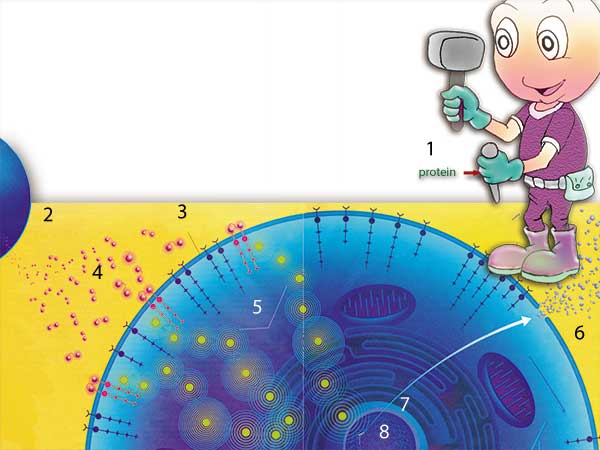When any organ wishes to produce a given protein, it sends a message to the cells. When the "messenger" molecule reaches the cell, it attaches to the antenna on the cell membrane. During this bonding, it transmits the message it carries by its very presence to the antenna, which then forwards the information it has received to its "tail" in the interior of the cell. The antennas, which at the outset were in a single state, now come together in paired groups. Enzymes in the body region alter the shape of the tail section by adding phosphate to it, in a process known as phosphorylation. All these processes are to summon the proteins in the cell known as communication molecules (Figure 81).
Several molecules and proteins provide technical support for this system. At this stage, molecules known as GTP—and those proteins referred to as G for short—have an important effect. If the system is to function effectively, it is vital that several factors all enter into play at the right moment (Figure 82).
It is evident that this communication system, whose first stage is described here in general terms, could hardly have come into being spontaneously, and that the unconscious atoms comprising the cell could not have thought up such a system. It is Almighty God Who created this perfect system from nothing. God is He Who inspires all living things with what they need to do and Who keeps them under His control at all moments.
 | |
| 1. Protein | 5. Signal paths |
| Figure 81: Communications inside the cell begin with molecules such as hormones that bear messages. Receptors in the cell membrane receive the message and forward it to the molecules inside the cell responsible for communications. This leads to the activation of various genes in the DNA and the production of whatever protein the message specified. Figure 82: Many proteins and molecules provide technical assistance when the message regarding protein production reaches the cell, and then the DNA. The way that molecules—devoid of any awareness, intelligence or consciousness—behave with such marvelous harmony and collaboration is one of the clear manifestations of God's matchless creation and omniscience. God is the Almighty, the Sublime and Powerful. | |